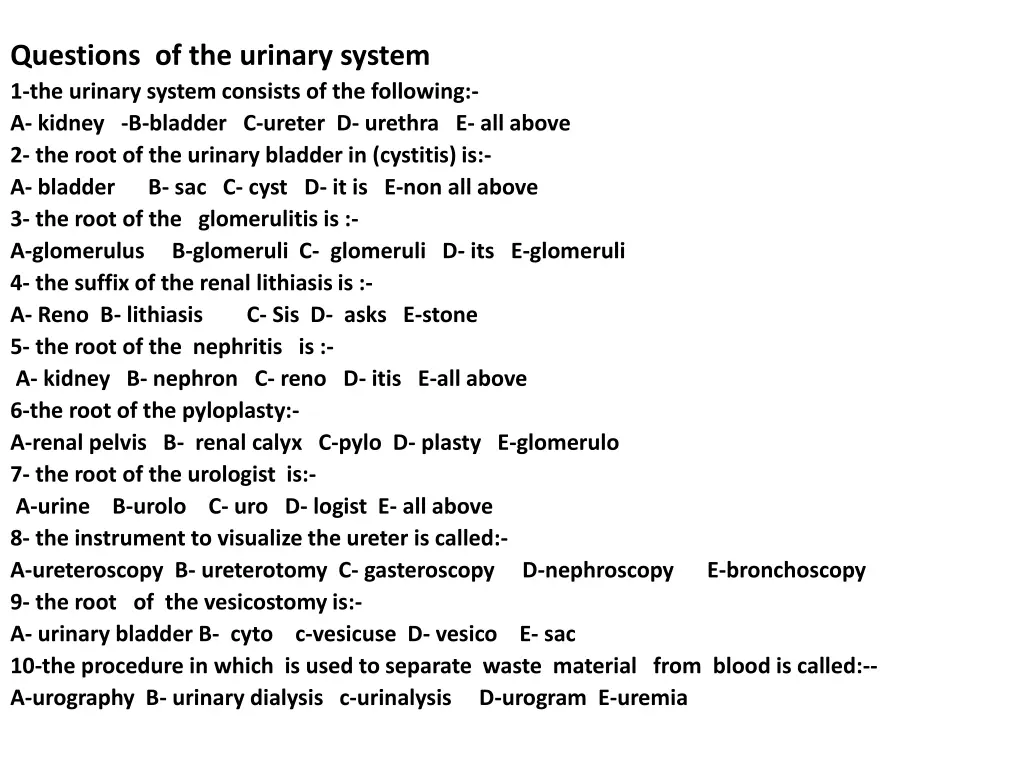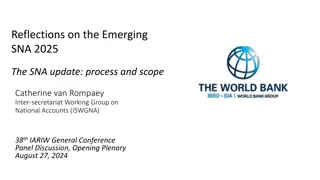
Urinary System Questions: Anatomy, Disorders, and Medical Terminology
Explore a comprehensive set of questions about the urinary system, covering anatomy, medical terms, and common disorders. Learn about the structure and functions of organs like the kidney, bladder, and urethra, as well as terms related to conditions like cystitis, nephritis, and lithiasis. Test your knowledge of urology terminology and diagnostic procedures, such as ureteroscopy and nephroscopy. Understand terms like polyuria, glycosuria, and albuminuria in the context of urinary system health.
Download Presentation

Please find below an Image/Link to download the presentation.
The content on the website is provided AS IS for your information and personal use only. It may not be sold, licensed, or shared on other websites without obtaining consent from the author. If you encounter any issues during the download, it is possible that the publisher has removed the file from their server.
You are allowed to download the files provided on this website for personal or commercial use, subject to the condition that they are used lawfully. All files are the property of their respective owners.
The content on the website is provided AS IS for your information and personal use only. It may not be sold, licensed, or shared on other websites without obtaining consent from the author.
E N D
Presentation Transcript
Questions of the urinary system 1-the urinary system consists of the following:- A- kidney -B-bladder C-ureter D- urethra E- all above 2- the root of the urinary bladder in (cystitis) is:- A- bladder B- sac C- cyst D- it is E-non all above 3- the root of the glomerulitis is :- A-glomerulus B-glomeruli C- glomeruli D- its E-glomeruli 4- the suffix of the renal lithiasis is :- A- Reno B- lithiasis C- Sis D- asks E-stone 5- the root of the nephritis is :- A- kidney B- nephron C- reno D- itis E-all above 6-the root of the pyloplasty:- A-renal pelvis B- renal calyx C-pylo D- plasty E-glomerulo 7- the root of the urologist is:- A-urine B-urolo C- uro D- logist E- all above 8- the instrument to visualize the ureter is called:- A-ureteroscopy B- ureterotomy C- gasteroscopy 9- the root of the vesicostomy is:- A- urinary bladder B- cyto c-vesicuse D- vesico E- sac 10-the procedure in which is used to separate waste material from blood is called:-- A-urography B- urinary dialysis c-urinalysis D-urogram E-uremia D-nephroscopy E-bronchoscopy
11- the diabetic patient complains of night urination for many times ,so he has :- A- polyuria B-dysuria c-nocturia D-pyouria E- hematuria 12- the patient complains of little amount of micturition daily ,so he has: A dysuria B- polyuria C- oliguria D-nocturia E- frequency 13- the sugar in the urine of diabetic patient is called:- A-enuresis B- diuresis C- proteinuria D-glycosuria E-nocturia 14-patient cannot possess urine ,so he suffers from:- A-dysuria B-diuresis C- anuria D-enuresis E-polyuria 15- the blood in the urine is called :- A- hematemesis B- hemoptysis C- hematuria D-hematazia 16-the root of glomerulonephritis is called:- A-glomero B- glomeruli o C-nephro D-(B+C) E-it is 17-the patient cannot controls micturition .so he has:- A- urine incontinence B-hesitancy C-anuria D-diuresis E-polyuria 18- the root of the nephrolithiasis Is:- A-kidney B- lithiasis nephro D-reno E-nephrol 19-Alittle amount of urine daily is called :- A- polyuria B- anuria C-dysuria D- oliguria E-diuresis 20-the study of disorder of urinary system is called:- A-nephrology B-urology C- urologist D- nephrologist E- all above
21-the procedure is used to eliminating stone in kidney ureter and bladder is called:- A-ESWL B-renal transplantation C-dialysis D-urinary catheterization E-nephrectomy 22- the presence bacteria in the urine is called:- A-polyuria B-crystalluria C-hematuria D-ketonuria E-bacteriuria 23- the presence of the albumin in the urine is called :- A- proteinuria B- nocturia C- glycosuria D- pyouria E-albuminuria 24- the abnormal narrowing of the urethra is called :- A- ureter stenosis B-arteriostenosis C-urethral stenosis D-aortic stenosis E-urinary incontinence 25-the operation for visualization of ureter by instrument is called:- A- cystoscopy B- urethroscopy C- cystectomy D- nehproscopy E- ureterstomy 26- the formation of new blood cells from stem cells is : A-hematopoiesis B- hematoma C hematology D-hemorrhage C- hematuria 27- hemophilia means :- A-blood in urine B- blood disorder C- breakdown of red blood cells D-stopping of bleeding E-blood in the chest 28-the disease of hemoglobin is called :- A-hemoglobinpathy B-anemia C-hemolysis D-hemophilia C-hemoglobinuria 29- The level of sugar in blood in diabetic patient is:- A-hypoglycemia B- hyperglycemia C- hypertension D-hypotension E- hyperemesis
30-the infection of the blood i called:- A-septicemia B- bacteremia C-anemia D- hyperalbminemia E-hypoalbminemia 31-the suffix of erythrocyte is:- A-erythema B-cyte C - ocyte D-red blood cells E- non all above 32- the abnormal increasing in number of R.B.C is called is:- A-erythrocytopenia B-erythrocytosis C- erythroblast D-erythropoiesis 33-the a granular leukocytes are divided into :- A- basophil B- acidophil C-neutrophil D-all above E- non all above 34-the a granular leukocytes are divided into:- A-lymphocyte B-monocytes C-(A+B) E- all above 34- the thrombocyte means :- A- R.B.C B-W.B.C C- platelet D- mast cells E-plasma cells 34-the disorder of coagulation mechanism due to defect of platelet:- A-leukocytopenia B-leukocytosis C-thrombocytopathy D-neutrophila E- monocytosis 35- the lymphatic system consist of the following except :- A- lymphatic vessels B- lymph node C- thymus D-tonsil E- liver 36-the anemia with the abnormal small red blood cell is called :- A-macrocytic anemia B- microcytic anemia C-sickle cell anemia D- thalassemia E- hemophalia
35- decreasing in the function of bone marrow is called :- A-myelosuppression B-myelitis C-myeloma D-myelofibrosis E-myelomeningocele 36-the root of the vasculitis is:- A- vas o B- ango C- vasculo D- non all above E-all above 37- the inflammation of the vein is called:- A- venography B- venitis c- phlebitis D-venostenosis 38-regarding to the lymphatic vessels are true except : A- have valve B-contain lymph C- divided into superficial and deep lymphatic vessels D-fallow the route of the arteries E- it is part of lymphatic System 39- regarding to the thymus gland is true except:- A-endocrine gland B- exocrine gland C-lymphatic organ D- secret thymosin hormone E-locates behind the sternum 40- regarding to the tonsils:- A-lymphatic organ B- part of the respiratory system C-produce lymphocytes D- part of immunity system E-all above 41- regarding to the spleen :- A- lymphatic tissue B- part of digestive system C-produce whit blood cells C- filter the blood from dead red blood cells E- all above 42-regarding to the adenoid:- A-cluster of lymphoid tissues B-continue in growing after 7 th year age old C-its excision is not affected on immunity D-hanging in back of nasal cavity E- all above E-vein ulcer
48-regarding to payers patch is all true except :- A-cluster of lymphoid tissue B-locate in colon C- locate in ilium D-defiance system in gastrointestinal system E- all above 48- the root of the lymph node is :- A-lymph/o B- lymphangi/o C- adenoid/o D-lymphodo/o E- pnumon/o 49- the root of the lienorenal ligament A-lien/0 B-ren/o C-(A+B) D- all above E- ligament 50 the root of the spleen is :- A- spleen/o B- splen/o C- lie /o D-(B+C) E- non all above 51-technique of X-ray of lymphatic vessels after injection the dye is called:- A-MRI B-ANA C-monosopot D-lymphangiogram E- lymphangiography 52- the signs of the inflammation are :- A-redness B- hot C- pain D-swelling E- all above 53-The disease which result from the inflammation and narrowing of air way due inhalation of allergen:- A-contact dermatitis B- allergic conjuctivitis C-allergic asthma D-pnumonia E-adenoitis 54-(sudden drop in blood pressure , breathing blocking , fast and weak pulse with vomiting and nausea is:- A-multiple myeloma B-mononuclosis C- anaphylactic shock D- tonsilitis E-thyoma 55- the root of lymphangioma is ;- A- lymph/o B- lymphan/o C-lymphangi/o D- oma E- not all above
65-the cancer of lymphocytes of lymph nodes:- A-Hodgkin's disease B-AIDS C-elephantiasis D- lymph edema E-lymphadenitis 66- the suffix of the lymphadenopathy is:- A- lymph/o B-lymphoadeno C- aden/o D- pathy E- adenopathy 67- the root of the lymphadenitis is:- A-lymph/o b- lymphaden/o C-aden/o D-( A+B+C) E- all above 68-The root of dysphagia is :- A- swallowing B- dys C- phage D- ia E- all above 69- the musculoskeletal system consists of the following:- A- bones B- muscles and tendons C- cartilages and ligaments D- joints E- all above 70-the function of the musculoskeletal system is ::- A- protection B- storage C-production D- movement E- all above The articulation between two adjacent bone or more is called :- A- tendon B- ligament C-joint D-cartilage E-muscle 71-which the muscle contains single spindle nucleus ? A-cardiac muscle B- smooth muscle C- skeletal muscle D- all above E-non all above 72* which the muscle voluntary in movement ? A- cardiac muscle B- smooth muscle D- skeletal muscle D- all above E- non all above 73- The root of the wrist is :- A- oste/o B-sacr/o C-carp/o D coccg/o E-ischi/o
74-the root of the foot is :- A-ped/o B- pod /o C-ankyl/o D-stren/o E-( A+B) 75- the root of the neck is A- cost B-kyph C-lord/o D- cervic/o E- tars/o 76- the root of the opening of the skull is :- A- cervic /o B-crain/o C-scapul/o D-patell/o E-clavicl/o 77- the root of the movement is :- A-kinesa/o B- kines/o c- fasc/o D-(A+B) E-brus/o 78- the root of the muscle is:- A- myo B- musculo C-myos D-all above E- non all above 79- the root of the tendon is :- A-tendin B- ten/o C-ten D- all above E- non all above 80- the root of the ossification is:- A- oste/o B-fication C- ossi/o D- bone E- non all above 81- the root of the spondylosis is:- A- vertabra B- osis C- spondyl/o D- spond E- non allabove 82- the root of the cartilage is :- A- cost/o B- ost/o C- chondr/o D-my/o E-arth/o 83- sudden muscle contraction is called:- A-adhesion B- myotonia C-spasm D-contracture E-intermitted claudication
84-the prefix of the bradykinesia is A-brady B- kinesia C- movement D- slow E- not all above 86- the root of the myotonia is :- A-myo B- tone C- Ia D-(A+B) E- all above 86- the increasing in the muscle bulky is :- A-dystonia B- hypotonia C- atonia D-hypertonia E- hyper atrophy 87- person specialized in treatment of the disorderof joints is called :- A* orthopedic B-orthopedist C-rheumatology D-Rheumatologist E-orthopedic surgery 88- The abnormal displacement of joints the from original place is called :- A-fracture B- clonus C- dislocation D- flaccid E- fibromyalgia 88-theabnormal increasing in convexity in the curvature of thoracic spine is called:- A-lordosis B- scolosis C- kyphosis D-torlicollis 89- the examination of interior of the joint by instrument through small incision is called:- A-arthocentesis B-bone scan C-computed tomography D-Arthoscopy 90- the degenerative changes in on joint or more is called:-- A- Rheumatic arthritis B-poliomyelitis C-myasthenia D-osteoarthritis E-strain 91-lateral epicondylitis means: A-strain B-ganglion cyst C- myopathy D- tennis elbow E- wry neck 92- surgical repair of the muscle is called :- A-myoplasty B- myorrhaxi C- myorraphy D- myositis E- myoma 93-incision of the tendon is called:- A-tendoplasty B-tenotomy C-tendonitis D-tenorraphy E-tendeous E-myalagia E-bone densitmetry






















